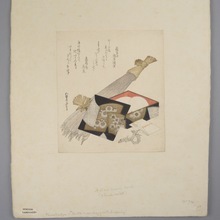Umafubuki
MOA: University of British Columbia
3212/1
Colour woodblock print "Horse Burdock" from the Umazukushi series (Series of Horses). This surimono depicts ingredients for osechi-ryōri, traditional Japanese dishes served on New Year’s day, featuring a bundle of burdock by a lacquered box containing rice cakes, and two sardines in the foreground. An envelope, used for money gifts, also appears.
-
History Of Use
A surimono 摺物 (literally, “printed things”) is a particular genre of Japanese woodblock print, and refers to privately commissioned or issued prints distributed in limited editions, mainly produced in the 1790s–1830s. They often include images and poetic inscriptions or verses. While surimono were designed in various sizes and formats, the design format was more or less standardized by around 1810. Shikishiban (c. 20.5 x 18.5 cm) was one of the standardized formats. Surimono were often commissioned as gifts or for special occasions such as the New Year; they were not sold to the public for commercial gain. The New Year is the most important holiday in Japan. Still life was a popular subject in surimono designs, but neglected in typical ukiyo-e prints.
-
Narrative
Signed Fusenkyo Iitsu hitsu (不染居為一筆, painted by Fusenkyo Iitsu) in the bottom left. Fusenkyo Iitsu is one of many pseudonyms the artist used. Two kyōka (狂歌, comic or satirical poems) appear. This surimono entitled Umafubuki (馬蕗) is believed to be one of thirty-three prints in the series Umazukushi (馬盡), commissioned for the year of the horse in 1822. The images in this series are not of horses, but are evoked from words associated with the word uma (horse). The series title is missing from this print.
-
Iconographic Meaning
The title of the work, umafubuki is an old name for gobō or burdock. Typical dishes for osechi-ryōri have symbolic meanings. Because of its long tap root, gobō symbolizes a long life. Tatsukuri or tazukuri, a dish made with baby sardines, represents a good harvest as dried sardines were used as a fertilizer for rice farming in the past. Rice cakes or mochi, a symbol of longevity, are added to ozōni, a special soup made during the New Year celebration.
-
Specific Techniques
While surimono were designed in various sizes and formats, the design format was more or less standardized by around 1810. Shikishiban (around 20.5 x 18.5cm) was one of such standardized formats. Surimono often include images and poetic inscription or verses.
- Type of Item print
- Culture Japanese
- Measurements height 43.0 cm, width 35.0 cm (overall) height 21.4 cm, width 18.8 cm (image)
- Creator Hokusai Katsushika
- Previous Owner Morris and Helen Belkin Art Gallery
- Received from Morris and Helen Belkin Art Gallery
- Made in Japan
- Creation Date during 1822
- Ownership Date before October 25, 2016
- Acquisition Date on October 25, 2016
- Item Classes works on paper
- Condition good
- Accession Number 3212/0001
